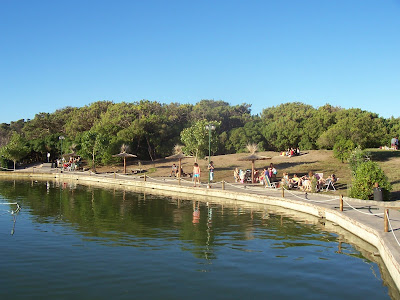Pre-Spanish era: The region was inhabited by Günuna Kena nomads (also known as northern Tehuelches). They were later (after the 11th century) strongly influenced by the Mapuche culture.
1577–1857: First European explorers. Sir Francis Drake made a reconnaissance of the coast and its sea lion colonies; Don Juan de Garay explored the area by land a few years later. In 1742, during the War of Jenkin's Ear, eight survivors of HMS Wager, part of Admiral Anson expedition, and led by Isaac Morris, lived through a ten-months ordeal before being decimated and captured by the Tehuelches, who eventually handed them to the Spaniards. After holding the Englishmen as prisoners, they returned Morris and his companions to London in 1746.[13] First colonization attempt by Jesuit Order near Laguna de los Padres ended in disaster (1751).
1857–1874: The Portuguese entrepreneur Coelho de Meirelles, taking advantage of the country’s abundance of wild cattle, built a pier and a factory for salted meat, but the business only lasts a few years.
1874–1886: Patricio Peralta Ramos acquired the now abandoned factory along with the surrounding terrain, and founded the town on February 10, 1874. Basque rancher Pedro Luro bought a part of Peralta Ramos land for agricultural production. First docks also erected around this time.
1886–1911: The railway line from Buenos Aires, built by the Buenos Aires Great Southern reached Mar del Plata in 1886; the first hotels started their activity. The upper-class people from Buenos Aires became the first tourist of the new born village. They also established a local government that reflected their conservative ideals. Build-up of a French style resort.
1911–1930: The residents, mostly new arrived immigrants from Europe, demanded and obtained the control of the Municipality administration. The socialist were the mainstream political force in this period, carrying out social reforms and public investment. The main port was also built and inaugurated in 1916.
1930–1946: A military coup reinstated the Conservative hegemony in politics through electoral fraud and corruption, but in the local level they were quite progressive, their policies viewed in some way as a continuity of the socialist trend. The seaside Casino complex opened in 1939, was designed by architect Alejandro Bustillo, and Highway 2, the main road to Buenos Aires, also dates from this period.
1946–1955: Birth of the Peronist movement. A coalition between socialists and radicals defeated this new party by a narrow margin in Mar del Plata, but by 1948 the Peronism will dominate the local administration. The massive tourism, triggered by the welfare politics of Perón and the surge of the middle class marked a huge growth in the city’s economy.
1955–1970: After the fall of Perón, the socialists regained the upper hand in local politics; the city reached the peak in activities like construction business and building industry. Massive immigration from other regions of Argentina.
1970–1989: Slight decline of tourism demand, counterbalanced by the increasing of other industries such as fishing and machinery. General infrastructure renewal under the military rule. The centrist Radical Civic Union becomes the main political force after the return of Democracy in 1983.
1989–Present: Though the Peronism replaced the radicals in central government amid a national financial crisis, the latter party continued to rule in Mar del Plata. Some resurge of mass tourism in the early '90s was followed by a deep social crisis in town, with an increase of poverty, jobless rate and emigration. By contrast, the first decade of the 21st century shows an amazingly quick recovery in all sectors of the ailing economy.
On November 2005 the city hosted the 4th Summit of the Americas.




























